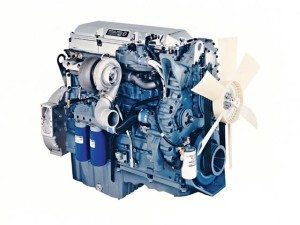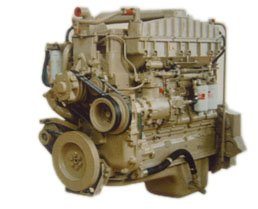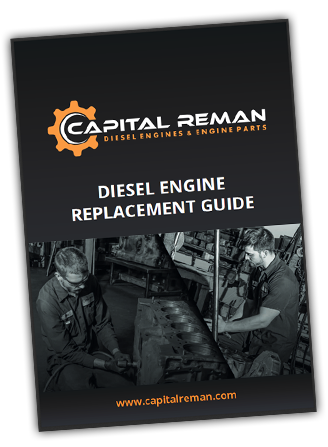10 Best and Worst Diesel Engines in History
 Ah the elusive diesel engine: power, strength and the raw horsepower to get the things done. You can’t go wrong with diesel and in this author’s humble opinion you’re already way ahead of the curve if you go diesel vs a puny gas engine. Ok we get it. Diesel is awesome but what diesel truck engine out there is truly the BEST? Cummins guys will fight until their dying breath that the Cummins 5.9 is arguably the best diesel engine ever made while CAT or PowerStroke gents will look in disbelief at the verbal diarrhea spewing forth from their buddies’ mouths. The debate is as old as Rudolf Diesel himself. Well good thing I don’t have to be “The Decider”… I don’t need that kind of pressure. Good thing someone else is willing to take the bullet for me. The guys over at Capital Reman, have given it their best shot to rank the Top 10 Best and Worst diesel engines of all time. This article is about what they came up with. What do ya’ll think? Did they hit the nail on the head or completely miss the target on this one?
Ah the elusive diesel engine: power, strength and the raw horsepower to get the things done. You can’t go wrong with diesel and in this author’s humble opinion you’re already way ahead of the curve if you go diesel vs a puny gas engine. Ok we get it. Diesel is awesome but what diesel truck engine out there is truly the BEST? Cummins guys will fight until their dying breath that the Cummins 5.9 is arguably the best diesel engine ever made while CAT or PowerStroke gents will look in disbelief at the verbal diarrhea spewing forth from their buddies’ mouths. The debate is as old as Rudolf Diesel himself. Well good thing I don’t have to be “The Decider”… I don’t need that kind of pressure. Good thing someone else is willing to take the bullet for me. The guys over at Capital Reman, have given it their best shot to rank the Top 10 Best and Worst diesel engines of all time. This article is about what they came up with. What do ya’ll think? Did they hit the nail on the head or completely miss the target on this one?
Honorable Mention: The Cummins B-Series
Why We Like It: This engine wasn’t the first Cummins Engine to bring some respectability to the medium duty diesel engine market but it surly refined it. The 4BT, 6BT and ISB 5.9L engines absolutely killed it in the torque rating capability. You need to tow something these engines have got you covered. Honorable mention on the best diesel engine of all time list isn’t too shabby.
The Specs:
• Engine Type: Four Stroke, Six Cylinder, Inline
• Bore x Stroke: 4.02 x 4.72 in
• Displacement: 359 ci (5.9L)
• Fuel Injection: Electronic high-pressure common rail
• Construction: Cast-iron block and head
• Compression Ratio: 17.2:1
• Maximum Power: 325 hp
• Maximum Torque: 610 lb-ft
5. International DT-466
Why We Like It: What’s not to like about this engine?! If you’ve ever driven on a public highway you’ve probably passed 47 trucks running a DT-466 engine. Baby, this engine hauls America’s freight on a daily basis and is the backbone of the medium-duty fleets all over the country. It is a favorite of fleet managers because they run forever, have great torque to power ratio and can actually be rebuilt right in the frame of the truck. Number 5 seems fitting for the best diesel engine for the sheer number of units currently still on the road.
The Specs:
• Type and Description: Four Stroke, Six Cylinder, Inline
• Displacement: 466 ci (7.6L)
• Bore and Stroke: 4.59×4.68 in
• Compression Ratio: 16.4:1
• Governed Speed: 2,600 rpm
• Total Engine Weight (dry): 1,425 lb (647 kg)
• Maximum Power: 170-350 hp
• Maximum Torque: 860 lb-ft
Worst International Engine: VT-265, VT-265, VT-335, VT-365 Series (Became PowerStroke 6.0L)
Why We Hate It: The VT-265 and VT-335 in particular were part of the International Light Duty models released in 2003. Ford adopted the Powerstroke officially in 2003 but was unofficially in production starting in 1994. The predecessors were bigger 6 cylinders however an International bean counter decided it would be a grand idea to chop off 2 of the cylinders producing a 4 cylinder engine. This didn’t go over too well and the VT-265 and VT-335 were horribly under-powered. Best diesel engine? I think not.
4. Mack E-7
Why We Like It: Ruff! Ruff! Ruff! Grrrr… That’s a good boy! What’s not to love about the Mack Bulldog. Mack truck engines have been around since 1893 when the Mack Brothers bought Fallsen & Berry Wagon Company in Brooklyn, New York. Mack has always been known as a slow and steady workhorse. It produced its first hook and ladder fire engine in 1909, produced over 6,000 trucks for the US and British Military during WWI and helped build the Hoover Dam in 1933. Its engines are known for their crankshaft to wheel torque ratio. These are the engines that built America. The Mack E-7 was first produced in 1988 and lasted until the early 21st century. They are extremely simple to overhaul and rebuild and do exactly what you need for them. They won’t win any races but are extremely reliable engines. When you think of the best diesel engine you can’t leave out the bulldog. Good on ya Mack!
The Specs:
• Engine Type: Four Stroke, Six Cylinder, Inline
• Displacement: 672-998 ci (11.01- 16.35L)
• Bore and Stroke: 6.50×6.70 in
• Fuel Delivery: Unit fuel injection
• Aspiration: Turbocharged
• Governed Speed: 1,700-1,800 rpm
• Maximum Power: Up to 454 hp
• Maximum Torque: Up to 1,660 lb-ft
Worst Mack Engine: None… Macks are Awesome! That and there only like 5 models. E-6, E-7, E-Tech, MP8, MP11 etc… all pretty solid.
3. CAT 3406E
Why We Like It: It’s good to be The King! It is amazing how many people bleed yellow and rightfully so in most cases. There have been some catastrophic failures in the Caterpillar line of engines; the 3406E is not one of them. The CAT 3406 comes in the A,B,C and E models and then evolved into the CAT C15 then CAT C15 Acert engine. This was a very successful engine for CAT as it was really the first evolved electronic engine that was done right. This was such a great engine that the vast majority of Peterbuilt trucks in the mid 90s and 00s all had Caterpillar 3406E engines in them. The ECM design was easy to work with and bread a following of programmers that were able to write a variety of software for the engine. This “open source” concept with the ECM allowed end users to “hot rod them up” to add more horsepower and torque to the engine via the injectors, camshaft or valve timing. Even in 2016 the CAT 3406E is still in millions of on-road and off-road applications across the world. Overall Caterpillar is the unofficial king of diesel engines and it deserves its place as number 3 on the best diesel engine list.
The Specs:
• Engine Type: Four Stroke, Six Cylinder, Inline
• Displacement: 893.39 ci (14.64L)
• Bore and Stroke: 6.50×6.70 in
• Fuel Delivery: Unit fuel injection
• Aspiration: Turbocharged
• Compression Ratio: 14.5:1
• Governor Speed: 1,800-2,100 rpm
• Maximum Power: 375-465 hp
• Maximum Torque: Up to 1,850 lb-ft
Worst Caterpillar Engine: 3116
Why We Hate It: It’s not that we hate the CAT 3116 it’s that we hate the fact that it’s hard to work on. It is extremely hard to time the fuel system and like the VW on the automotive side, working on the CAT 3116 requires special tooling you can only buy from Caterpillar. Typically, it costs up to $5000 in tooling to work on the 3116. The other reason we don’t care much for the 3116 is that it is quite under-powered compared with a Cummins 5.9 or 6BT. The CAT 3116 was engineered to be disposable. Albeit the 3116 was used in a wide variety of application including many marine applications the CAT 3126 and later the CAT C7 were arguably better models. To conclude the CAT 3116 isn’t a terrible engine but is damn near at the bottom of the best diesel engine list.
2. Cummins 855 Big Cam
Why We Love It: How could you not immediately fall in love with this engine from the name alone? Kind of rolls off the tongue eh?! The Cummins 855 Big Cam was the last real mechanical variable timing engine mass produced by Cummins in the 1976. The Big Cam replaced the small cam 855 and was the first engine by Cummins to meet the Clean Air Act and noise regulations of that time. There were four generations of the Cummins Big Cam 855 engines, last produced in 1985 and was replaced by the N14. We love the 855 Big Cam because of the raw horsepower it puts out as well as its reliability. You can easily run a Cummins 855 Big Cam 700,000 miles before an overhaul. The Cummins 855 Big Cam was the first engine by Cummins to utilize demand-flow cooling which only cools the engine when the engine demands it. This system then uses the saved horsepower at the crankshaft for more horsepower into the project at hand. The Big Cam II significantly upgraded performance by introducing pulse manifolds into the engines; these were a big selling feature in these engines at the time. Overall horsepower was the main reason this engine was a big seller over the small cam models. The Cummins 855 Big Cam had one of the largest camshaft diameters on the market at the time and features top-stop injectors. Talk to any old school truck drivers in the 1970s and they will tell you tales when the Cummins 855 series were the king of the road. Hard not to leave these engines off the best diesel engine of all time list. There were some drawbacks with the 855 specifically when trying to start the engine in colder climates. The 855 uses a lower pressure fuel injection system at 2,200 psi to power the injectors and varying timing specs, oil/water pump and valve spring pressures. That being said a glow plug or a shot of ether should do the trick to fix this simple issue because overall this is a great engine.
The Specs:
• Engine Type: Four Stroke, Six Cylinder, Inline
• Displacement: 856 ci (14 L)
• Bore and Stroke: 5.50×5.98 in
• Fuel Delivery: Unit fuel injection
• Aspiration: Turbocharged
• Compression Ratio: 10:1
• Governed Speed: 1,800 rpm
• Maximum Power: Up to 605 hp
• Maximum Torque: Up to 1,118 lb-ft
Worst Cummins Engine: Cummins ISX
Why We Hate It: The Cummins ISX was originally released in 2001 which replaced the longstanding N14 engine of the late 80s and 90s. It was supposed to be the Caddalic and the best diesel engine every designed at Cummins. However that didn’t pan out exactly. The ISX was engineered with a dual overhead cam design; one cam accessed the valve train and the other took care of the actuating injectors. In 2002 the ISXCM870 integrated the Exhaust Gas Recirculation (EGR) which takes the exhaust gas and recirculates it back into the intake of the engine. What this does is lower the combustion chamber temperatures limiting the formation of NOx. A neat concept but there were many issues with this system that caused many engine failures. The main point of failure is the dual overhead cam design which overly complicated things and caused many snowball effect types of issues in the engine. Lastly, the early versions of the ISX had a whole host of issues with the ECM which caused a sour taste in many Cummins owners mouths. In 2010 Cummins re-designed the ISX with a single overhead design to simplify things but the damage was done. This was supposed to be Cummins entrance into the electronic world however it was much too complicated for its own good. It is rightfully so belongs off the best diesel engine list; disappointing indeed.
1. Detroit Diesel Series 60
Why We Love It: Hands down the Detroit Diesel Series 60 is the best diesel engine ever produced for the class 8 world. Fun fact of the day: the Detroit Diesel Series 60 was mostly developed by John Deere although how much of an influence Deere had is debatable. The Detroit Diesel Series 50 cylinder heads were casted by John Deere Engine Company. In the early 1970s GM’s Detroit Diesel had roughly 41% market share of all diesel engines sold in America. By the early 1980s that number had shrunk to roughly 4% market share. GM knew the company was in trouble and sought out help from John Deere engineers to re-establish their reputation. There was a proposed joint-venture between the two companies that didn’t pan out however JD engineers purportedly designed the ring-system which fixed a lot of issues the Series 60 had with oil leakage problems as well as developed the cylinder head design. The main caveat of the Series 60 was the introduction of the first electronically controlled engine with the proprietary “DDEC” or Detroit Diesel Engine Control technology. The proposed company was to be known as “DEDEC” or Detroit Engines, Deere Engine Company. However the joint venture never came to fruition but the engine control technology took off.
The first diesel ECM was wildly popular with consumers due to its ease of use and updates in real time to the driver. Functions in the DDEC system included engine diagnostic functions, shutdown timers, progressive shift functions, fault history and record keeping, speed limiting governors, cruise control and automatic stall preventing. The cruise control technology was particularly popular with fleet managers due to its fuel-saving function but most notably DDEC system allowed the operator to download engine management reports regarding use of the engine, provide record of over-speeding, excessive idle time, hard breaking and other parameters. The DDEC allowed dealers to change the horsepower settings and in some cases propriety software was able to be loaded into the computer. The system was easy to operate and diagnostic codes were displayed to the driver in real time: red indicator lights signaled a major problem while a yellow light was less of a serious issue. Detroit Diesel did not invent the modern day ECM but rather adapted General Motors ECM technology from the early 1980s into diesel technology. The first ECM was created by BMW in 1939 for the Kommandogerat airplane during WWII. The DDEC boom set in motion the electronic era for diesel engines.
The Series 60 became the most popular selling diesel engine for Detroit Diesel and the company went on to produce the DDEC I, DDEC II, DDEC III, DDEC IV and 14L/DDEC V hybrid engines from 1987-2007. The Series 60 was first major diesel engine that did open the lead cam on the bigger bore. The DDEC IV got up to 575 hp before being replaced by the 14.0 L engine in 2007. There are millions of Detroit Diesel Series 60 engines still on the road today and it is extremely easy to remanufacture Detroit Diesel Series 60 engines due to their unrestricted open source design. For 20 years Freightliner and Penske trucks all had exclusive contracts to include Series 60 engines in their trucks. All heil the king of diesel, may it continue to live in the history books as the best diesel engine in the world.
The Specs:
• Engine Type: Four-cycle, six-cylinder, inline
• Displacement: 778-855 ci (12.7- to 14.0L)
• Bore and Stroke: 5.24×6.61 in
• Fuel Delivery: Unit fuel injection
• Aspiration: Turbocharged
• Governed Speed: 2,100 rpm
• Maximum Power: Up to 515 hp
• Maximum Torque: Up to 1,650 lb-ft
Worst Detroit Engine: All old two-stroke Series 50, V-71 or V-92, technology. Good stuff but technology has surpassed these old engines. The old two stroke technology is easy to work on but boy that stuff is past its prime.
Well there you have it: the best diesel engines of all time… followed by the subsequent worst diesel engines. No matter what diesel engine you’ve got in your big rig or skid loader it’s probably not too shabby. You can’t go wrong with a diesel. Let the discussion begin!




